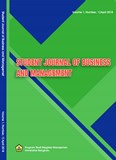Main Article Content
Abstract
Abstract:
Technological developments are increasingly making all activities easier, many sophisticated technologies are emerging that enable business people to develop their business strategies. The development of information technology and telecommunications also makes the market more dynamic, requiring business people to constantly improvise and innovate for retaining customers. E-Service Quality is designed as an extension of a site's ability to facilitate effective, efficient, effective shopping, purchasing and distribution activities. The aims to this research quality of service from Tokopedia and find out what criteria of quality must be improved. This research was conducted by using fuzzy method and E-Servqual (Service Quality). The analysis was carried out using 20 criteria from 6 dimensions which were efficiency, fullfilment, system availability, privacy, responsiveness, contact. The results showed that the service quality at Tokopedia was good. Overall, what users expect already accordance with Tokopedia’s performance. There is one dimension that has a negative value called fullfilment. From the defuzzyfication value of expectations and perceptions of the 20 criteria, 4 criteria were found with negative gap values and 16 others with positive gap values. By using a Cartesian diagram, criteria are determined to be the main priority where Tokopedia users feel that these criteria are very important. However, the service provided by Tokopedia for the fullfilment dimension is not good enough. The criteria as follows: Tokopedia keeps its promises for the offers provided, the suitability of the exact and up-to-date product delivery tracking location points, Tokopedia application system does not fail, and provide a TANYA chat room which is very helpful in providing information and complaints.
Keywords: Quality of Service, Fuzzy Method, Servqual, Tokopedia.
Abstrak:
Perkembangan teknologi semakin mempermudah segala aktivitas, banyak bermunculan teknologi canggih yang memungkinkan para pelaku bisnis untuk mengembangkan strategi bisnisnya. Perkembangan teknologi informasi dan telekomunikasi juga membuat pasar semakin dinamis, menuntut para pelaku bisnis untuk terus berimprovisasi dan berinovasi untuk mempertahankan pelanggan. E-Service Quality dirancang sebagai perpanjangan dari kemampuan situs untuk memfasilitasi kegiatan belanja, pembelian dan distribusi yang efektif, efisien, efektif. Penelitian ini bertujuan untuk mengetahui kualitas layanan dari Tokopedia dan mengetahui kriteria kualitas apa saja yang harus ditingkatkan. Penelitian ini dilakukan dengan menggunakan metode fuzzy dan E-Servqual (Service Quality). Analisis dilakukan dengan menggunakan 20 kriteria dari 6 dimensi yaitu efisiensi, pemenuhan, ketersediaan sistem, privasi, daya tanggap, kontak. Hasil penelitian menunjukkan bahwa kualitas pelayanan di Tokopedia sudah baik. Secara keseluruhan, apa yang diharapkan pengguna sudah sesuai dengan kinerja Tokopedia. Ada satu dimensi yang memiliki nilai negatif yaitu fullfilment. Dari nilai defuzzyfikasi harapan dan persepsi dari 20 kriteria, ditemukan 4 kriteria dengan nilai gap negatif dan 16 kriteria lainnya dengan nilai gap positif. Dengan menggunakan diagram kartesius, ditentukan kriteria menjadi prioritas utama dimana pengguna Tokopedia merasa kriteria tersebut sangat penting. Namun pelayanan yang diberikan Tokopedia untuk dimensi fullfilment kurang baik. Kriterianya sebagai berikut: Tokopedia menepati janji atas penawaran yang diberikan, kesesuaian titik lokasi tracking pengiriman produk yang tepat dan up-to-date, sistem aplikasi Tokopedia tidak gagal, dan menyediakan chat room TANYA yang sangat membantu dalam memberikan informasi dan pengaduan.
Kata kunci: Kualitas Pelayanan, Metode Fuzzy, Servqual, Tokopedia.
